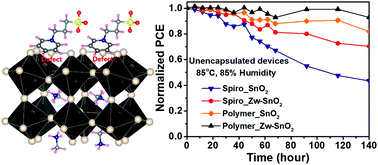Thermally stable, planar hybrid perovskite solar cells with high efficiency†
Abstract
We report a highly effective interface engineering strategy for thermally stable perovskite solar cells (PSCs) by employing a zwitterion-modified SnO2 electron transport layer (ETL) and a dopant-free hole transport layer (HTL). A zwitterionic compound, 3-(1-pyridinio)-1-propanesulfonate, is used to modify the SnO2 ETL. The zwitterion, which forms interfacial dipoles, plays a few important roles: (1) it causes shifts in the work function of SnO2 resulting in more efficient charge extraction and an increase in the built-in potential. (2) It pulls electrons from perovskite layers to the ETL/perovskite interface, enhancing the electron transport ability. (3) Interfacial dipoles prevent back transfer of electrons from the ETL to the perovskite and suppress charge recombination. (4) Positively charged atoms in the zwitterion passivate Pb–I antisite defects, improving the stability of devices. With these desirable properties, the PSC with doped Spiro-OMeTAD obtained a power conversion efficiency of 21.43%. In addition, the PSC with the dopant-free HTL exhibited a record high efficiency of 20.5% among dopant-free polymeric HTLs using green solvents. The resulting PSCs without encapsulation showed excellent thermal stability. Accordingly, this work suggests that the use of a modified ETL and a dopant-free HTL is a promising strategy to overcome the thermal instability of planar-PSCs (P-PSCs).



 Please wait while we load your content...
Please wait while we load your content...